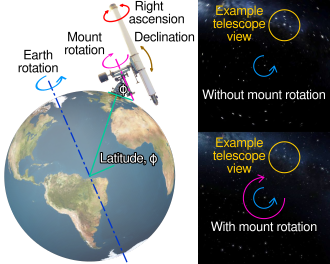
Back محور استوائي Arabic Muntura equatorial Catalan Montierung#Parallaktische Montierungen German Ekvatorialo EO Montura ecuatorial Spanish استقرار استوایی FA Monture équatoriale French מעמד משווני HE Ekvatorska montaža Croatian Montatura equatoriale Italian

An equatorial mount is a mount for instruments that compensates for Earth's rotation by having one rotational axis, called polar axis, parallel to the Earth's axis of rotation.[1][2] This type of mount is used for astronomical telescopes and cameras. The advantage of an equatorial mount lies in its ability to allow the instrument attached to it to stay fixed on any celestial object with diurnal motion by driving one axis at a constant speed. Such an arrangement is called a sidereal drive or clock drive. Equatorial mounts achieve this by aligning their rotational axis with the Earth, a process known as polar alignment.

- ^ "LAS MONTURAS". Observatorio J. A. Soldevilla. Archived from the original on 2018-07-28. Retrieved 2008-09-20.
- ^ "Observatorio ARVAL - Polar Alignment for Meade LXD55/75 Autostar telescopes". Observatorio ARVAL.